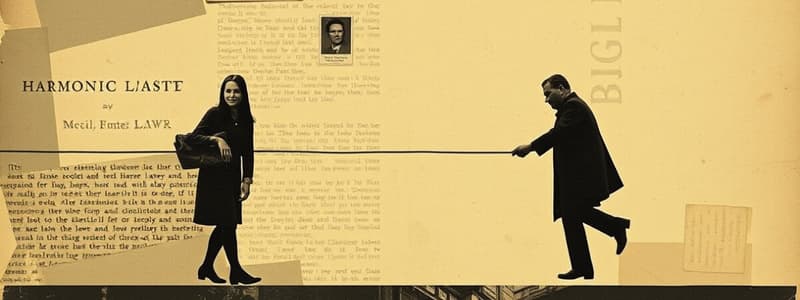Podcast
Questions and Answers
What does Hooke's Law state about the restoring force acting on a deformed object?
What does Hooke's Law state about the restoring force acting on a deformed object?
- The restoring force is proportional to the displacement from its equilibrium position. (correct)
- The restoring force is only applicable to springs.
- The restoring force is independent of the displacement.
- The restoring force is inversely proportional to the displacement.
Which of the following statements about simple harmonic motion (SHM) is correct?
Which of the following statements about simple harmonic motion (SHM) is correct?
- Acceleration is independent of displacement.
- Displacement is maximal when velocity is zero. (correct)
- Velocity is maximal when both displacement and acceleration are zero.
- Acceleration is constant throughout the motion.
What is the SI unit of frequency?
What is the SI unit of frequency?
- Meter (m)
- Second (s)
- Newton (N)
- Hertz (Hz) (correct)
What does the amplitude of an oscillating spring represent?
What does the amplitude of an oscillating spring represent?
How is the period of a simple pendulum defined?
How is the period of a simple pendulum defined?
How does Hooke’s Law relate displacement and restoring force?
How does Hooke’s Law relate displacement and restoring force?
Explain the relationship between velocity, displacement, and acceleration in simple harmonic motion when displacement is at its maximum.
Explain the relationship between velocity, displacement, and acceleration in simple harmonic motion when displacement is at its maximum.
In the context of simple harmonic motion, what happens to acceleration when displacement is zero?
In the context of simple harmonic motion, what happens to acceleration when displacement is zero?
What is the significance of frequency in simple harmonic motion?
What is the significance of frequency in simple harmonic motion?
How is amplitude defined in relation to equilibrium position in oscillatory motion?
How is amplitude defined in relation to equilibrium position in oscillatory motion?
Flashcards are hidden until you start studying
Study Notes
Hooke’s Law and Elastic Constant
- Hooke’s Law states that the restoring force (F) is proportional to the displacement (s) from an object’s equilibrium position.
- The elastic constant (k) is the proportionality constant in Hooke's Law, indicating the stiffness of a material.
- The SI unit of the elastic constant is Newton per metre (N m⁻¹).
Simple Harmonic Motion (SHM)
- SHM is periodic motion in which acceleration is proportional to and directed towards the displacement from equilibrium.
- When velocity is maximal, displacement and acceleration are both zero.
- When displacement is maximal, acceleration is also maximal while velocity is zero.
- Examples of SHM include:
- A mass oscillating on a spring.
- A simple pendulum oscillating within small angles.
- A compass finding its North-South direction.
Amplitude in SHM
- Amplitude (A) is the maximum distance an object moves from its equilibrium position.
- The SI unit of amplitude is metre (m).
- In a spring, the amplitude of oscillation corresponds to the difference between its natural and actual lengths.
Frequency and Period
- Frequency (f) measures the number of cycles or oscillations per unit time, expressed in hertz (Hz).
- One hertz (1 Hz) equals one cycle per second.
- The period (T) is the time taken for one complete oscillation and is dependent on the pendulum's length and gravitational acceleration.
Relationships and Dynamics
- The elastic constant (k) relates restoring force (F) to displacement (s) via F = k * s.
- Increasing frequency results in a decrease in the period of oscillation.
- The period of a simple pendulum is directly proportional to the square root of its length.
- Angular frequency (ω) is calculated as ω = √(k/m), relating elastic constant to mass.
Effects of Gravity on Pendulum
- Increasing gravitational acceleration decreases the period of a pendulum.
- Doubling a pendulum's length results in doubling its period.
Valid Experiment Precautions
- To ensure valid results during pendulum experiments, oscillations must occur in a single plane.
Force and Displacement in Hooke's Law
- Force (F) is directly proportional to displacement (s) as stated by Hooke's Law.
- A spring with an elastic constant (k) of 1.47×10^5 N m⁻¹ indicates extreme rigidity.
Displacement and Velocity in SHM
- At maximum displacement during SHM, acceleration is maximal while velocity is zero.
- The velocity of an object is maximal when passing through the equilibrium position.
Key Units and Measurements
- The SI unit of amplitude in SHM is metre (m).
- Springs exhibit a restoring force that directly correlates to the elastic constant (k).
Examples and Understanding SHM
- A pendulum swinging back and forth is a prime example of SHM.
- As a spring is stretched, displacement increases in proportion to the applied force.
Hooke’s Law and Elastic Constant
- Hooke’s Law states that the restoring force (F) is proportional to the displacement (s) from an object’s equilibrium position.
- The elastic constant (k) is the proportionality constant in Hooke's Law, indicating the stiffness of a material.
- The SI unit of the elastic constant is Newton per metre (N m⁻¹).
Simple Harmonic Motion (SHM)
- SHM is periodic motion in which acceleration is proportional to and directed towards the displacement from equilibrium.
- When velocity is maximal, displacement and acceleration are both zero.
- When displacement is maximal, acceleration is also maximal while velocity is zero.
- Examples of SHM include:
- A mass oscillating on a spring.
- A simple pendulum oscillating within small angles.
- A compass finding its North-South direction.
Amplitude in SHM
- Amplitude (A) is the maximum distance an object moves from its equilibrium position.
- The SI unit of amplitude is metre (m).
- In a spring, the amplitude of oscillation corresponds to the difference between its natural and actual lengths.
Frequency and Period
- Frequency (f) measures the number of cycles or oscillations per unit time, expressed in hertz (Hz).
- One hertz (1 Hz) equals one cycle per second.
- The period (T) is the time taken for one complete oscillation and is dependent on the pendulum's length and gravitational acceleration.
Relationships and Dynamics
- The elastic constant (k) relates restoring force (F) to displacement (s) via F = k * s.
- Increasing frequency results in a decrease in the period of oscillation.
- The period of a simple pendulum is directly proportional to the square root of its length.
- Angular frequency (ω) is calculated as ω = √(k/m), relating elastic constant to mass.
Effects of Gravity on Pendulum
- Increasing gravitational acceleration decreases the period of a pendulum.
- Doubling a pendulum's length results in doubling its period.
Valid Experiment Precautions
- To ensure valid results during pendulum experiments, oscillations must occur in a single plane.
Force and Displacement in Hooke's Law
- Force (F) is directly proportional to displacement (s) as stated by Hooke's Law.
- A spring with an elastic constant (k) of 1.47×10^5 N m⁻¹ indicates extreme rigidity.
Displacement and Velocity in SHM
- At maximum displacement during SHM, acceleration is maximal while velocity is zero.
- The velocity of an object is maximal when passing through the equilibrium position.
Key Units and Measurements
- The SI unit of amplitude in SHM is metre (m).
- Springs exhibit a restoring force that directly correlates to the elastic constant (k).
Examples and Understanding SHM
- A pendulum swinging back and forth is a prime example of SHM.
- As a spring is stretched, displacement increases in proportion to the applied force.
Studying That Suits You
Use AI to generate personalized quizzes and flashcards to suit your learning preferences.




